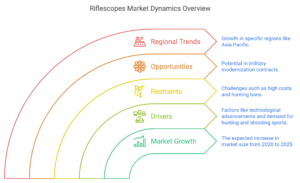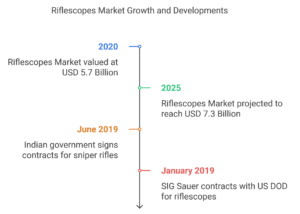Understanding Riflescopes: What They Are and How They Work
Riflescopes are optical devices attached to firearms that enhance accuracy by providing a telescopic view of the target. Used extensively in hunting, shooting sports, and military operations, riflescopes enable shooters to maintain target precision at varying distances. Let’s break down their components and functionality.
How Riflescopes Work
Riflescopes typically consist of lenses, a reticle, and a magnification control mechanism. Here’s how these elements function together:
- Objective Lens: The front lens gathers light, which enhances the image clarity of the target, especially in low-light conditions.
- Eyepiece and Ocular Lens: The ocular lens magnifies the light from the objective lens, forming a clear, sharp image.
- Reticle: The reticle, or crosshairs, serves as the aiming point, helping the shooter align the target.
- Elevation and Windage Controls: These adjustment knobs allow for precise targeting adjustments, compensating for bullet drop and wind.
- Parallax Adjustment: This adjustment feature ensures the reticle remains fixed on the target even as the shooter shifts positions.
Advanced riflescopes today include digital displays, ballistic calculators, and rapid zoom technology, enhancing their utility in dynamic environments.
Growth Drivers in the Riflescopes Market
Several factors contribute to the growth of the Riflescopes Industry. Here’s an overview of some of the primary drivers:
1. Technological Advancements for Precision
In military applications, precision is paramount. Advances like Rapid Adaptive Zoom for Assault Rifles (RAZAR) technology allow military personnel to switch between high and low magnifications with the push of a button, without having to remove their eyes from the target. Companies like Bushnell and Vortex Optics offer advanced RAZOR technology that has revolutionized riflescope performance in combat.
Other innovations include:
- Integration with night vision goggles: Essential for nighttime operations.
- Smart rifle compatibility: Integrating riflescopes with ballistic data and digital interfaces for real-time analytics.
2. Increased Demand for Hunting and Shooting Sports
Hunting and shooting sports have gained popularity, especially in North America, Europe, and parts of Asia. Riflescopes provide an enhanced experience, allowing hunters and sports enthusiasts to shoot with greater accuracy over longer distances. This recreational demand contributes significantly to the market, with an estimated 40-45% revenue from riflescopes used in hunting applications.
3. Military Modernization Programs
Military modernization is a significant driver of the riflescopes market. Countries are upgrading their defense systems, including their optical weaponry, to enhance combat readiness. Notable contracts include:
- SIG Sauer’s contract with the US DOD: SIG Sauer provides the Electro-Optics Tango6T 1-6×24 SFP Riflescope and Alpha4 Ultralight Mount, improving the US Special Operations Forces’ capabilities.
- India’s procurement: The Indian government has signed contracts with companies like Beretta and Barrett to supply sniper rifles with advanced riflescope systems.
Download PDF Brochure: https://www.marketsandmarkets.com/pdfdownloadNew.asp?id=216692701
Opportunities in the Riflescopes Market
With rising investments in military modernization and an increasing consumer base for hunting optics, there are several growth opportunities in the riflescopes industry.
1. Military Procurement and Modernization Programs
Global military forces are upgrading optical weaponry to increase battlefield accuracy. In addition to high-tech riflescopes for snipers, many armies are integrating scopes with new assault rifles, creating a market for contracts and government procurement.
2. Growing Demand for Advanced, High-Powered Scopes
Consumers are looking for enhanced optical solutions with features like laser range-finding, image stabilization, and wireless connectivity. Telescopic riflescopes with high magnification are projected to grow at the highest CAGR during the forecast period, due to their demand in both military and recreational markets.
3. Demand for Night Vision and Thermal Imaging Scopes
Night vision and thermal imaging technologies have seen rapid adoption, especially in military and law enforcement. These optics are increasingly becoming part of advanced riflescope systems, offering a clear vision in low-light and difficult conditions, ideal for hunting or tactical operations.
Market Challenges
The riflescopes industry faces certain challenges that may impact growth over the forecast period. Here are some notable ones:
1. High Cost of Riflescopes
Riflescopes are expensive, particularly those with advanced features like high magnification, night vision, or ballistic calculators. The price varies significantly, making it challenging for some customers to afford premium products. Companies have to balance high-quality features with affordable prices to attract a larger consumer base.
2. Ban on Hunting in Certain Countries
Countries with stringent wildlife conservation regulations, such as Costa Rica and India, have banned hunting to protect endangered species. Since hunting contributes nearly half of riflescope revenues, these regulations pose a potential threat to market growth in certain regions.
3. COVID-19 Impact on Supply Chains
The COVID-19 pandemic disrupted global supply chains, impacting the manufacturing of optical components and lenses. The pandemic also led to delays in shipments and orders, although essential military contracts were largely unaffected. As operations resume, the supply chain is expected to stabilize, but long-term impacts may still linger.
Key Market Players in the Riflescopes Industry
The Riflescopes Market is highly competitive, with several companies holding significant market share. Major Players include:
- SIG Sauer, Inc. (US)
Known for its Electro-Optics Tango6T Riflescope, SIG Sauer supplies high-quality optics to the US Department of Defense, securing its position as a market leader. - Vortex Optics (US)
Vortex Optics produces versatile, high-powered riflescopes with features like RAZAR technology, catering to both the commercial and military sectors. - Leupold & Stevens, Inc. (US)
A reputable name in the riflescopes market, Leupold & Stevens won a military optics contract worth USD 42.8 million, supplying the US military with advanced Mark 6 riflescopes. - Burris Company, Inc. (US)
Burris Company focuses on precision optics for hunting and military use, offering durable scopes designed for harsh environments. - Nightforce Optics (US)
Nightforce supplies premium riflescopes to the US SOCOM, with advanced optical technology to support military applications. - Trijicon, Inc. (US)
Trijicon manufactures scopes with enhanced illumination and night vision, serving both civilian hunters and military forces.
Recent Developments in the Riflescopes Market
Leupold & Stevens’ Partnership with Aimpoint
Leupold & Stevens collaborated with Aimpoint to supply Mark 6 riflescopes and integrated mounting systems, marking a significant step toward next-generation optical aiming systems for modern rifles.
Nightforce’s USD 15 Million Contract with US SOCOM
In 2020, Nightforce Optics was awarded a contract to supply Squad-Variable Powered Scopes, advancing the US Special Operations Command’s capabilities in combat environments.
SIG Sauer’s USD 12 Million Contract for Electro-Optics TANGO6T
SIG Sauer continues to expand its presence with a contract to provide Electro-Optics Tango6T riflescopes to the US Special Operations Forces, securing a stable market share in military optics.
Frequently Asked Questions (FAQs)
Q1: What is the size of the global riflescopes market?
The riflescopes market was valued at USD 5.7 billion in 2020 and is expected to reach USD 7.3 billion by 2025, growing at a 5.0% CAGR.
Q2: Who are the key players in the riflescopes market?
Major players include SIG Sauer, Vortex Optics, Leupold & Stevens, Burris Company, Nightforce Optics, and Trijicon.
Q3: How has COVID-19 impacted the riflescopes market?
COVID-19 affected global manufacturing and supply chains, but military contracts helped maintain demand for riflescopes.
Q4: What are some technological advancements in riflescopes?
Technological advancements include night vision integration, ballistic calculators, precision-guided systems, and adaptive zoom technology.
Q5: What factors are driving market growth?
Key drivers include rising demand for hunting optics, technological advancements, and military modernization programs.
To Gain Deeper Insights Into This Dynamic Market, Speak to Our Analyst Here: https://www.marketsandmarkets.com/speaktoanalystNew.asp?id=216692701
Key Takeaways
- Market Growth: Expected to grow from USD 5.7 billion in 2020 to USD 7.3 billion by 2025, driven by precision optics advancements.
- Key Drivers: Military modernization, demand for hunting scopes, and technological innovation are driving growth.
- Challenges: High costs and hunting bans may limit market expansion.
- Opportunities: Military contracts and demand for night vision scopes present opportunities for growth.
- Major Players: Leading companies include SIG Sauer, Vortex Optics, Leupold & Stevens, and Nightforce Optics.
The riflescopes market continues to expand, spurred by advancements in optical technology and growing demand across military and recreational sectors. As the industry evolves, staying informed about trends, key players, and market dynamics is crucial for investors and enthusiasts alike.


